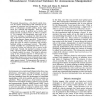Free Online Productivity Tools
i2Speak
i2Symbol
i2OCR
iTex2Img
iWeb2Print
iWeb2Shot
i2Type
iPdf2Split
iPdf2Merge
i2Bopomofo
i2Arabic
i2Style
i2Image
i2PDF
iLatex2Rtf
Sci2ools
AAAI
1994
1994
Teleassistance: Contextual Guidance for Autonomous Manipulation
We present teleassistance, a two-tiered control structure for robotic manipulation that combines the advantages of autonomy and teleoperation. At the top level, a teleoperator provides global, deictic references via a natural sign language. Each sign indicates the next action to perform and a relative and hand-centered coordinate frame in which to perform it. For example, the teleoperator may point to an object for reaching, or preshape the hand for grasping. At the lower level autonomous servo routines run within the reference frames provided. Teleassistance offers two benefits. First, the servo routines can position the robot in relative coordinates and interpret feedback within a constrained context. This significantly simplifies the computational load of the autonomous routines and requires only a sparse model of the task. Second, the operator's actions are symbolic, conveying intent without requiring the person to literally control the robot. This helps to alleviate many of ...
AAAI 1994 | Autonomous Servo Routines | Intelligent Agents | Servo Routines | Two-tiered Control Structure |
| Added | 02 Nov 2010 |
| Updated | 02 Nov 2010 |
| Type | Conference |
| Year | 1994 |
| Where | AAAI |
| Authors | Polly K. Pook, Dana H. Ballard |
Comments (0)

